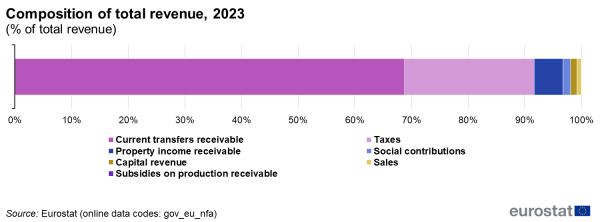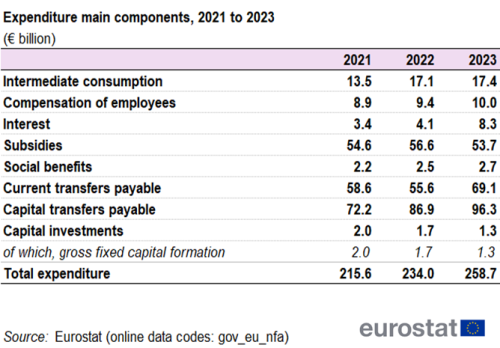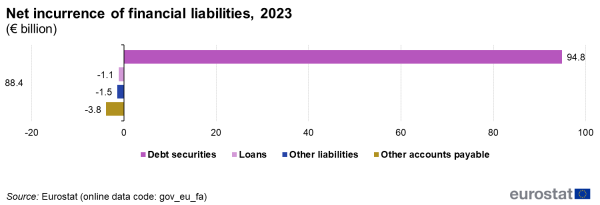Annual statistical accounts of the EU institutions and bodies subsector
Data extracted in July 2024
Planned article update: July 2025
This article presents the main indicators from the annual statistical accounts of the European Union institutions and bodies subsector for 2021 to 2023, based on ESA 2010.[1] They include Maastricht debt, total revenue, total expenditure and net lending/net borrowing.

(€ billion)
Source: Eurostat (gov_eu_nfa) and (gov_eu_debt)
The subsector of the EU institutions and bodies in national accounts covers the EU institutions and bodies financed by the EU budget, as well as the European Stability Mechanism (ESM), the European Financial Stability Facility (EFSF), the Single Resolution Board/Single Resolution Fund (SRB/SRF) and the Modernisation Fund. These institutions have separate budgetary and accounting structures, different funding methods and different memberships and policy mandates.
The statistics presented in this article provide an aggregate view for the European Union institutions and bodies' sub-sector and its dynamics over the years. They should not be used as the basis for assessing the financial situation of the individual institutions and bodies, which should be performed on the basis of their published financial statements. The numbers presented in this article differ from the annual accounts of the EU published by Directorate-General for Budget (DG BUDG) due to differences in the accounting systems.
It should be noted that a substantial part of the observed net borrowing of the subsector of EU institutions and bodies in national accounts is due to the grants provided to the Member States through the Recovery and Resilience Facility (RRF) under the Next Generation EU, which is financed by debt to be repaid by future budgets (post-2028). These amounts do not form part of the EU annual budgetary procedure.
This information comes from data on debt and on financial and non-financial accounts published by Eurostat in its database.
Full article
Revenue and expenditure of the EU institutions and bodies subsector
In 2023, the main components of the EU institutions and bodies’ revenue were current transfers receivable and taxes.
Current transfers receivable, which made up 68.8% of total revenue, concern mainly transfers made by the Member States to the EU Budget in relation to own resources based on GNI, VAT and non-recycled plastic packaging waste. Among these transfers, the GNI-based resource, which amounted to €97.7 billion in 2023, represents 48.8% of the total revenue of the EU institutions and bodies.
Current transfers receivable remained rather stable over 2022 and 2023. In 2023, the VAT based own resource, plastic own resources, and other revenues together showed a slight increase, compared with 2022, thus resulting in a lower share of the GNI-based revenue in 2023 compared with 2022.
In 2023, taxes were lower than in 2022. This is mostly due to decreases in custom duties, related to relevant reductions in the custom duties established in November and December 2023. Furthermore, the SRB/SRF revenue from contributions from banks – recorded as other taxes on production, in national accounts – also decreased in 2023.
Property income receivable more than doubled in 2023, as compared with 2022. This can be explained by the rising interest rates and the on-going increase of the stocks of interest-bearing assets held by the EU institutions and bodies sector. It is worth noting that in 2023 property income receivable was higher than interest payable, observed on the expenditure side (see Table 3 below).
Figure 2 depicts the composition of total expenditure of the EU institutions and bodies in 2023. In 2023, the main components of the total expenditure of the EU institutions and bodies were capital transfers payable, current transfers payable and subsidies.

(% of total expenditure)
Source: Eurostat (gov_eu_nfa)
Current and capital transfers payable, which made up 63.9% of total expenditure, concern mainly the payments made in the context of the European Structural and Investment Funds, such as the European Regional Development Fund and the European Social Fund Plus. They also include the non-repayable support provided in the context of the RRF that are financed by proceeds of debt issuance, which will be repaid from future budgets (post-2028).
The increase in capital and current transfers payable in 2023 is partly explained by the increased absorption of RRF grants at Member State level. It was also the result of the increased expenditure of the European Regional Development Fund, the Cohesion Fund and the European Social Fund, due to the usual increase of national absorption of funds towards the end of the previous programming period, as well as because national absorption of the new programming period starts to accelerate.
Maastricht debt liabilities of the EU institutions and bodies subsector and its financing
The Maastricht debt liabilities of the EU institutions and bodies and other institutions included in the subsector of EU institutions and bodies stood at €740.1 billion, at the end of 2023, before consolidation with the EU Member States.
Maastricht debt means total consolidated gross debt at nominal (face) value, outstanding at the end of the year. It comprises liabilities in currency and deposits, debt securities and loans.
As shown in Figure 3, the vast majority (96.2%) of end-2023 debt is in the form of long-term debt securities. Debt securities are negotiable financial instruments which have defined basic terms such as an issue date, the coupon rate the issuer pays to holders, the original maturity date, an issue price at which investors buy the debt securities when first issued and a redemption price (or face value), which is the amount to be paid by the issuer to the holder at maturity.
The debt of the EU institutions and bodies subsector before consolidation with Member States increased by €98.3 billion in 2023. The increase mainly reflects the new net borrowings to finance NGEU grants (€48.0 billion) and loans (€34.1 billion) and MFA[2] loans to Ukraine (€18 billion), partly offset by some decreases in debt liabilities, notably of the ESM (minus €9.8 billion). Most of the increase was in the form of long-term debt securities.
More information reconciling the €58.7 billion net borrowing and the €98.3 billion change in Maastricht debt can be found in the stock-flow adjustment (see Table 6 at the end of the section “Data coverage, sources and methods” below).
It should be noted that the major part of the Maastricht debt of the EU institutions and bodies sector concerns issuances with the aim of on-lending to the Member States. Loans extended to the Member States are assets of the EU institutions and bodies sector, but at the same time they are liabilities of the Member States included in their Maastricht debt. Furthermore, some of the EU institutions and bodies invest in securities issued by Member States debt agencies and other general government entities. Moreover, the European Commission keeps funds deposited in accounts at the treasuries of the Member States.
Table 5 shows that, by end-2023, the debt of the EU institutions and bodies subsector after consolidating the assets it holds against Member States governments stood at €168.5 billion.

(€ billion)
Source: Eurostat (gov_eu_debt)
The major share of EU institutions and bodies debt that is not aimed at on-lending to Member States concerns the debt issued to fund the grants provided in the context of the NGEU/RRF. Some amounts of non-consolidating debt concern borrowing for loans to non-EU Member States (e.g., in the context of the macro-financial assistance (MFA)), financial leasing, repurchase agreements and cash collateral received for financial derivatives’ contracts. To have a complete picture of the financial position of the EU institutions and bodies subsector it is, therefore, very important to consider its debt after consolidating the assets this subsector holds against the Member States.
Figure 4 shows the net incurrence of liabilities of the EU institutions and bodies in 2023.
The €88.4 billion net incurrence of financial liabilities in 2023 is mostly the result of the net incurrence of debt securities of €94.8 billion in 2023, which in turn is mainly explained by the net issuances of the European Commission, in the form of EU bonds and EU bills, aimed at funding the grants and loans under RRF as well as loans under the MFA programme.
Figure 5 shows that the biggest share of the €29.6 billion net acquisition of assets of the EU institutions and bodies in 2023 relates to net granting of loans (€46.6 billion), which notably includes loans provided by the European Commission in the context of the RRF (€34.1 billion) and a further MFA loan provided to Ukraine (€18.0 billion). In the opposite direction, €7.1 billion of loans were repaid by the Member States to the ESM/EFSF and on the European Commission's EFSM[3] lending.
The positive net acquisition of debt securities assets of €35.7 billion is mainly explained by increased investments, in 2023, by the ESM, of which a substantial part was in Member States’ governments’ bonds. A smaller share concerns increased investments by the European Commission, notably in the Innovation Fund and the Common Provisioning Fund compartments.
The net disposal of other accounts receivable (€32.8 billion) is predominantly explained by the UK Withdrawal Agreement, mostly via cash contributions by the United Kingdom, and by an increased absorption of RRF and other funds which the European Commission had pre-financed.
Source data for tables and graphs
Data sources
Data coverage, sources and methods
The data cover the EU institutions and bodies financed by the EU budget (e.g., the European Commission, the European Parliament, the European External Action Service (EEAS) and the agencies) as well as the European Stability Mechanism (ESM), the European Financial Stability Facility (EFSF), the Single Resolution Board/Single Resolution Fund, and the Modernisation Fund, which are classified in sector S.1315[4].
The primary basis for this compilation is the underlying data of the Consolidated annual accounts of the European Union 2023, provided by DG Budget of the European Commission, the data underlying the ESM and EFSF annual reports, provided by ESM, the data underlying the annual accounts of the SRB/SRF, provided by the SRB, and data published concerning the Modernisation Fund. Aside from data, Eurostat works in close cooperation with these institutions, from which it receives several clarifications.
The compilation of annual statistical accounts of the EU institutions and bodies subsector follows the same approach used by the Member States for the compilation of their national general government sector accounts, i.e., starting from a public administrative source and applying to it the ESA 2010 methodology.
For the EU institutions financed by the EU budget, and for the Modernisation Fund, the compilation exercise starts from the budget (cash) accounts and then moves to accrual-based transactions. This is due to the fact that, in the ESA 2010 framework, transactions are recognised and recorded when economic value is created, transformed, exchanged, transferred or extinguished. For the ESM, the EFSF and the SRB/SRF, the exercise starts from already accrued information, to which some conceptual and methodological adaptations are applied.
There is thus sizeable overlap between International Public Sector Accounting Standards (IPSAS), and to some extent also International Financial Reporting Standards (IFRS), and statistical accounts compiled following the ESA 2010. However, a 1:1 comparison between the financial statements observed in the consolidated annual accounts of the European Union and the annual reports of the ESM, the EFSF and the SRB/SRF, on the one hand, and the data sub-sets published today by Eurostat, on the other hand, is not possible or valid, due to relevant presentational, conceptual and valuation differences.
The difference between total revenue and total expenditure — including capital expenditure (in particular, gross fixed capital formation) — equals net lending/net borrowing of general government, which is also one of the balancing items of the government non-financial accounts.
The reconciliation between the €58.7 net borrowing in year 2023 and the €98.3 change in Maastricht debt is showed in the stock-flow adjustment table below:

(€ million)
Source: Eurostat (gov_eu_nfa), (gov_eu_fa) and (gov_eu_debt)
Context
Background
In 2021, the Next Generation EU temporary instrument was launched with the aim to bring more than €800 billion in support to Europe's recovery from the Covid-19 pandemic, and to build a greener, more digital and more resilient Europe.
The European Commission has started borrowing on capital markets, implementing a diversified funding strategy with an open and transparent communication to market participants. The funding raised is being used to provide grants and loans to the Member States through the Recovery and Resilience Facility (RRF) under Next Generation EU, as well as for the SURE programme and to support Ukraine.
These developments have generated demands[5] for compiling statistical accounts of the EU institutions and bodies subsector based on the ESA 2010, thus bringing more transparency and a comprehensive picture of its financial position.
Direct access to
See also
Database
- Non-financial accounts for EU institutions (gov_eu_nfa)
- Financial accounts for EU institutions (gov_eu_fa)
- Debt of the EU institutions (gov_eu_debt)
Dedicated section
External links
Notes
- ↑ The main revisions, implemented for years 2021 and 2022, as compared to the previous publication, are mainly stemming from the inclusion in this compilation exercise of the SRB/SRF and the Modernisation Fund in the perimeter of the subsector EU institutions and bodies. As a result, the net borrowing improved and a decrease in the debt of the EU institutions after consolidation of assets against Member States was observed.
- ↑ Macro-Financial Assistance
- ↑ The European Financial Stabilisation Mechanism (EFSM) was created, before them ESM, for the European Commission to provide financial assistance in the form of back-to-back loans to any EU countries experiencing or threatened by severe financial difficulties.
- ↑ The government sector of EU institutions (similarly to the Member States) comprises entities financed by the EU Budget (European Commission, European parliament, etc.) and other bodies, namely the EFSF and the ESM, set-up for the support of euro area governments. Principles of sectorisation are set in the ESA 2010 Chapter 19 and para 20.09-20.10, which are developed further in the Manual on Government Deficit and Debt Chapter 1.9. Notwithstanding the statistical sectorisation rules, the EFSF and the ESM are, legally, not EU Institutions strictu sensu. The EFSF has the legal form of a limited corporation established in Luxembourg, while the ESM is legally an international financial institution.
- ↑ Council conclusions on EU statistics, November 2022 ([1])






